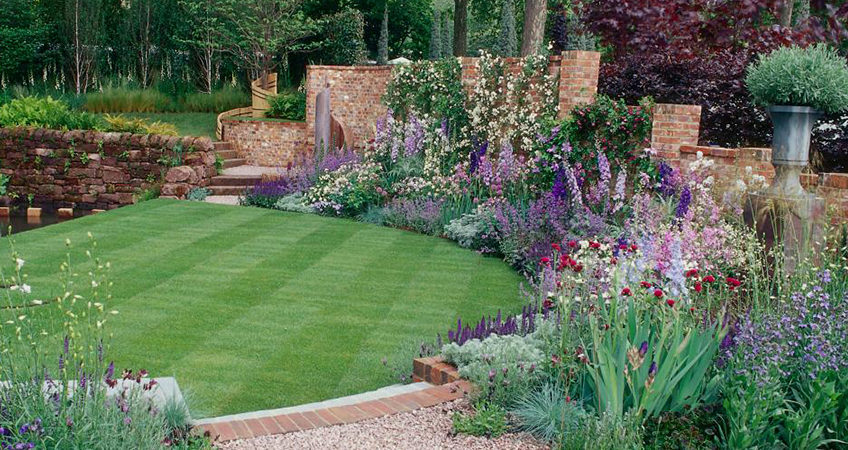Follow these 22 seasonal grass care tips to ensure your lawn looks healthy and green spring, summer, winter and fall.
Spring
Spring is the season when a lawn really needs some tender loving care as temperatures rise and the grass starts to grow, increasing its reliance on water and fertilizer.
Lay Sod and Sow Seed
Early spring is a good time for laying turf because the risk of frost is lower, making the soil more workable. Spring is also the ideal time for sowing seed as the soil warms up and rainy days speed germination.
Fertilize
A spring feed is essential to keep the lawn looking green. There are many pre-packaged feeds available; whichever one you choose make sure that the main ingredient is nitrogen, which encourages strong growth.
Water, If Necessary
Toward the end of spring it may be necessary to water occasionally if the last few months have been dry.
Mow Regularly
Cut the grass once a week, ensuring that the mower is raised to its highest setting (about 1 inch) for the first few cuts.
Scarify to Remove Thatch
Lightly scarify the lawn, using a spring-tined rake or a mechanical scarifier to remove dead grass, also known as thatch.
Aerate
Use a pitchfork or aerator to spike the lawn, this allows air to circulate to the grass roots and breaks up compacted soil.
Summer
Summer is the period when grass is at its most stressed, which means that some lawn care techniques, such as scarifying or aerating, should be avoided in periods of drought.
Feed
If necessary, lawns can receive another dose of fertilizer during the summer, but only if rainfall is predicted. In extremely dry or hot weather fertilizer will scorch and stress the lawn. As an alternative to granular fertilizer, liquid feeds, such as kelp tonics, can be applied.
Water
To keep the lawn looking green during a dry summer, it may be necessary to water it either with an irrigation system or manually with a garden hose or sprinkler. However, lawns can recover quickly from drought, so to conserve water, try to avoid watering except in extreme conditions.
Mow When Needed
Lawns will need mowing once or twice a week, although this should be stopped during extremely dry periods.
Eliminate Weeds
Remove pernicious weeds, such as dandelions, by digging them out of the ground, taking care to remove the whole root. Others, such as speedwell, clovers and daisies, usually need spraying to remove them; however, this should be avoided during periods of drought.
Fall
Autumn is the key season for lawn renovations. Fall care will help to ensure that the grass survives the low temperatures of winter. It will also help the lawn to recover from heavy usage during spring and summer.
Remove Leaves
Once you have raked up fallen leaves, shred them using a rotary mower then add them to the compost.
Compost Leaves
Leaves that fall onto the lawn must be raked up and removed to prevent the lawn from dying back due to lack of light. However, the fallen leaves can easily be converted into a rich, nutritious leaf mold that’s an excellent soil conditioner for shade-loving plants in beds and is also a great addition to potting soil mixes.
Fertilize
Whereas spring feeds are high in nitrogen to encourage the lawn to grow, the key ingredient in fall fertilizer mixes is potassium because this encourages strong growth and will toughen up the grass for winter.
Aerate
The lawn should be spiked down to about 3 to 4 inches with either a pitchfork or a mechanical aerator. Solid tining should be done every year, and about every three or four years hollow tining, shown above, can be performed instead.
Apply Top-Dressing
Spread a good quality top-dressing evenly over the lawn then brush it into the holes created by aerating; ensuring that it’s all brushed in, otherwise it will kill the grass. Commercial mixes can be bought, but you can make your own by mixing sand, good quality compost and loam.
Lay Sod and Sow Seed
This is a good time to lay turf or seed the lawn since the soil will be warm. This should also allow enough time for the lawn to establish itself before the onset of winter. Patches can be returfed, and hollows and bumps smoothed out. Small, bare patches are best covered by sowing grass seed.
Scarify to Remove Thatch
Use a spring-tined rake or a mechanical scarifier to rip the thatch out of the lawn. Scarify in two directions, the second time deeper than the first; this scarification should be more vigorous than the spring scarification. Rake up all the removed thatch and add it to the compost heap.
Winter
There is little to do with the lawn during winter while grass is dormant. If possible, avoid walking on it during frosty periods since this can leave black marks where the grass will eventually die back.
Clear Any Remaining Leaves
In mild conditions any remaining fallen leaves should be removed because they block out the light, killing the lawn. Leaves can be sucked up with a mower or raked up and added to the compost heap.

